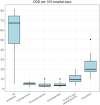Implementation of infection prevention and control components in Italian hospitals based on a nationwide survey on behalf of INSIEME project
- PMID: 41125745
- PMCID: PMC12546834
- DOI: 10.1038/s41598-025-20893-y
Implementation of infection prevention and control components in Italian hospitals based on a nationwide survey on behalf of INSIEME project
Abstract
We aim to assess the state-of-the-art of Infection Prevention and Control (IPC) practices and their results in Italian healthcare facilities 6 years after the kick-off of the new National Plan for the Control of Antibiotic Resistance (PNCAR). This was a multicenter, cross-sectional, observational study conducted between January 1st, and December 31st, 2023, among Italian hospitals. Survey questions were readapted from the WHO IPC assessment framework (IPCAF), PNCAR and INSIEME group proposals, resulting in 155 questions grouped into six sections: IPC program, surveillance, control activities for healthcare-associated infections, antimicrobial stewardship (AMS) strategies, IPC training and education, and monitoring indicators. Thirty-eight acute care Hospitals completed the survey (response rate: 30%): 26.3% of hospitals did not define an annual program and 34.2% an AMS task force. Periodic microbiology reports were available for 57.9%, hospital alcohol-based hand rubs consumption per 1000 bed-days in 42.1% and defined daily dose of antimicrobials per 100 bed-days in 55.3% hospitals with a significant difference between Northern and Southern regions (90.9% vs 22.2%; P = 0.006). Active monitoring of hand hygiene and contact isolation compliance was implemented in only half of the hospitals. Structured HAI surveillance systems were implemented in fewer than 20% of hospitals. Components on IPC implementation activity, such as no-touch sanitizing systems, checklist for environmental cleaning, informatic flags, bundles for pathogens revealed the lowest score. The appropriateness of antibiotic therapy prescribing was assessed in 73.7% of facilities. Only 42.1% of hospitals had budget goals. This survey provides a baseline assessment and identifies key barriers to the implementation of IPC programs across Italian acute care hospitals. The findings highlight priority areas for intervention and will inform the next phase of the INSIEME project, which aims to develop and implement tailored strategies that address the specific needs of healthcare workers and institutions nationwide.
Keywords: Antimicrobial resistance; Antimicrobial stewardship; Infection prevention and control.
© 2025. The Author(s).
Conflict of interest statement
Declarations. Competing interests: The authors declare no competing interests. Ethical statement: This study did not use any individual or patient data, and there was no involvement of members of the public or patients in its design or analysis. According to Italian law, ethics approval was not necessary for this research. This study was performed under the auspices of SIMIT.
Figures





References
-
- Christaki, E., Marcou, M. & Tofarides, A. Antimicrobial Resistance in Bacteria: Mechanisms, Evolution, and Persistence. J. Mol. Evol.88(1), 26–40. 10.1007/s00239-019-09914-3 (2020) (Epub 2019 Oct 28 PMID: 31659373). - PubMed
-
- Geneva: World Health Organization; Antimicrobial resistance. [Online]. Disponibile su: https://www.who.int/health-topics/antimicrobial-resistance. (2022).
-
- WHO/Newsroom/Spotlight. Geneva: World Health Organization; Ten threats to global health in 2019. [Online]. Disponibile su: https://www.who.int/news-room/spotlight/ten-threats-to-global-health-in-.... (2019).
-
- Meschiari, M., López Lozano, J. M., Medioli, F., Bacca, E., Sarti, M., Cancian, L et al. A time-series analysis approach to quantify change in antibiotic resistance and antibiotic consumption during COVID-19 Epidemics: a multicenter cross-national ecological study on behalf of QUARANTINE (QUantifying change in Antibiotic Resistance ANTibiotic use and INfection control during COVID-19 Epidemics) study project. Clin Microbiol Infect. S1198–743X (25)00296–4. (2025). - PubMed
Publication types
MeSH terms
LinkOut - more resources
Full Text Sources
Medical

